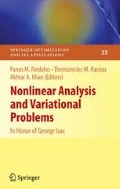Abstract
In this paper, we present various foundations of a new field of research in optimization unifying semidefinite and copositive programming, which is called set-semidefinite optimization. A set-semidefinite optimization problem is a vector optimization problem with a special constraint defined by a so-called set-semidefinite ordering cone. The investigations of this chapter are based on the paper [11].
Access this chapter
Tax calculation will be finalised at checkout
Purchases are for personal use only
Preview
Unable to display preview. Download preview PDF.
References
L.-F. Andersson, G. Chang and T. Elfving, “Criteria for copositive matrices using simplices and barycentric coordinates”, Linear Algebra Appl. 220 (1995) 9–30.
I.M.Bomze and E.de Klerk, “Solving standard quadratic optimization problems via linear, semidefinite and copositive programming”, J. Global Optim. 24 (2002) 163–185.
I.M. Bomze, M. Dür, E. de Klerk, C. Roos, A.J. Quist and T. Terlaky, “On copositive programming and standard quadratic optimization problems”, J. Global Optim. 18 (2000) 301–320.
J.M. Borwein, “Necessary and sufficient conditions for quadratic minimality”, Numerical Funct. Anal. Optimization 5 (1982) 127–140.
S. Bundfuss and M. Dür, “Criteria for copositivity and approximations of the copositive cone” (Preprint, Department of Mathematics, Darmstadt University of Technology, Darmstadt, 2006).
S. Bundfuss and M. Dür, “Algorithmic Copositivity Detection by Simplicial Partition”, Linear Algebra Appl. 428 (2008) 1511–1523.
S. Burer, “On the copositive representation of binary and continuous nonconvex quadratic programs”, Math. Program. 120(2009)479-495 DOI 10.1007/s10107-008-0223-z.
G. Danninger, “Role of copositivity in optimality criteria for nonconvex optimization problems”, J. Optimization Theory Appl. 75 (1992) 535–558.
E. de Klerk and D.V. Pasechnik, “Approximation of the stability number of a graph via copositive programming”, SIAM J. Optim. 12 (2002) 875–892.
I. Dukanovic and F. Rendl, “Semidefinite programming relaxations for graph coloring and maximal clique problems”, Math. Program. 109(2) (2007) 345–365.
G. Eichfelder and J. Jahn, “Set-semidefinite optimization”, J. Convex Anal. 15 (2008) 767–801.
M. Fukuda, M. Yamashita and M. Kojima, “Computational Prospects on Copositive Programming”, RIMS Kokyuroku 1526 (2006) 207–213.
M.X. Goemans, “Semidefinite programming in combinatorial optimization”, Math. Program. 79 (1997) 143–161.
M.S. Gowda, “A characterization of positive semidefinite operators on a Hilbert space”, J. Optimization Theory Appl. 48 (1986) 419–425.
J. Jahn, Vector Optimization - Theory, Applications, and Extensions (Springer, Berlin, 2004).
J. Jahn, Introduction to the Theory of Nonlinear Optimization (Springer, Berlin, 2007).
J. Jahn, Int. J. Optimization: Theory, Methods and Appl. 1 (2009) 123-139.
W. Kaplan, “A test for copositive matrices”, Linear Algebra Appl. 313 (2000) 203–206.
W. Kaplan, “A copositivity probe”, Linear Algebra Appl. 337 (2001) 237–251.
K. Löwner, “über monotone Matrixfunktionen”, Math. Z. 38 (1934) 177–216.
H. Maurer and J. Zowe, “First and second-order necessary and sufficient optimality conditions for infinite-dimensional programming problems”, Math. Programming 16 (1979) 98–110.
P.M. Pardalos, M. Panos and J.E. Xue, “The maximum clique problem”, J. Global Optim. 4(3) (1994) 301-328
J. Povh and F. Rendl, “Copositive and semidefinite relaxations of the quadratic assignment problem” (manuscript, University of Maribor, Faculty of Logistics, Celje, Slovenia, 2006).
J. Povh and F. Rendl, “A copositive programming approach to graph partitioning”, SIAM J. Optimization 18 (2007) 223–241.
A.J. Quist, E. de Klerk, C. Roos and T. Terlaky, “Copositive relaxation for general quadratic programming”, Optim. Methods Softw. 9 (1998) 185–208.
J.F. Sturm and S. Zhang, “On cones of nonnegative quadratic functions”, Math. Oper. Res. 28 (2003) 246–267.
M.J. Todd, “Semidefinite optimization”, Acta Numerica 10 (2001) 515–560.
L. Vandenberghe and S. Boyd, “Semidefinite programming”, SIAM Rev. 38 (1996) 49–95.
L. Vandenberghe and S. Boyd, “Connections between semi-infinite and semidefinite programming”, in: R. Reemtsen and J.J. Rueckmann, Semi-Infinite Programming (Kluwer, Boston, 1998), p. 277–294.
L. Vandenberghe and S. Boyd, “Applications of semidefinite programming”, Appl. Numer. Math. 29(3) (1999) 283–299.
H. Wolkowicz, R. Saigal and L. Vandenberghe (eds.), Handbook on Semidefinite Programming (Kluwer, 2000).
H. Väliaho, “Quadratic-programming criteria for copositive matrices”, Linear Algebra Appl. 119 (1989) 163–182.
J. Werner, Optimization, Theory and Applications (Vieweg, Braunschweig, 1984).
Acknowledgment
The authors thank Prof. Constantin Zălinescu for valuable discussions.
Author information
Authors and Affiliations
Corresponding author
Editor information
Editors and Affiliations
Additional information
Dedicated to the memory of Professor George Isac
Rights and permissions
Copyright information
© 2010 Springer Science+Business Media, LLC
About this chapter
Cite this chapter
Eichfelder, G., Jahn, J. (2010). Foundations of Set-Semidefinite Optimization. In: Pardalos, P., Rassias, T., Khan, A. (eds) Nonlinear Analysis and Variational Problems. Springer Optimization and Its Applications, vol 35. Springer, New York, NY. https://doi.org/10.1007/978-1-4419-0158-3_18
Download citation
DOI: https://doi.org/10.1007/978-1-4419-0158-3_18
Published:
Publisher Name: Springer, New York, NY
Print ISBN: 978-1-4419-0157-6
Online ISBN: 978-1-4419-0158-3
eBook Packages: Mathematics and StatisticsMathematics and Statistics (R0)

